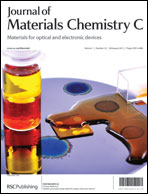Synthesis of all-deuterated tris(2-phenylpyridine)iridium for highly stable electrophosphorescence: the “deuterium effect”†
Abstract
Device stability and life-time rank the key issues for PhOLEDs. We synthesized deuterated Ir(ppy)3-D24. A device based on it has a current density twenty times higher than and a life-time six times longer than devices based on Ir(ppy)3. The more stable C–D bond is found to be the main contributing factor, called the “deuterium effect”.


 Please wait while we load your content...
Please wait while we load your content...